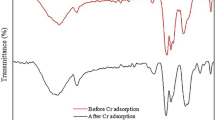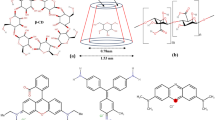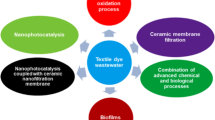Abstract
Water is one of the most essential natural resources in the ecosystem, yet anthropogenic pollution from variety of sources jeopardize this available resource. Turbid tannery effluent is the serious environmental hazard as it interfere photosynthesis of aquatic habitats by obstructing light penetration into the water body. In this research work, an attempt has been made to investigate the potential of graphene oxide (GO)–ferric oxide (MO) nanocomposites for the reduction of turbidity from tannery effluent. Nanocomposites were prepared using facile solution casting method and the dispersibility, material interactions, chemical bonding and morphology of as prepared nanocomposites were determined through UV–Vis spectroscopy, XRD, FT-IR, and TEM analysis, respectively. The effect of pH, adsorbent dosage, and contact time of nanocomposites have been studied for process optimization. At pH 6, about 95% of turbidity was removed by 2 gL−1 of nanocomposite adsorbent within 30 min. Moreover, both adsorption kinetics and isotherm models were studied during experimentation; pseudo-second-order kinetic equation and Freundlich isotherm model were well suited due to the chemisorption with multilayer adsorption and resulted turbidity removal from tannery wastewater. Here it is worth mentioning that the maximum adsorption capacity in Langmuir isotherm was 67.7 mg/g. Apart from turbidity, other parameters including chemical oxygen demand (COD), salinity and total suspended solids (TSS) was reduced up to 78, 56, and 76%, respectively, after the adsorption process.









Similar content being viewed by others
Availability of data and materials
Not applicable.
Code availability
Not applicable.
References
Aboubaraka AE, Aboelfetoh EF, Ebeid EZM (2017) Coagulation effectiveness of graphene oxide for the removal of turbidity from raw surface water. Chemosphere 181:738–746
Agarwal S, Tyagi I, Gupta VK, Dehghani MH, Ghanbari R (2016) Investigating the residual aluminum elimination from conventional and enhanced coagulation by phosphate compounds in wastewater treatment process. J Mol Liq 221:673–684
Ali I, Mbianda XY, Burakov A, Galunin E, Burakova I, Mkrtchyan E, Grachev V (2019) Graphene based adsorbents for remediation of noxious pollutants from wastewater. Environ Int 127:160–180
Amosa MK, Jami MS, Alkhatib MAFR, Tajari T, Jimat DN, Owolabi RU (2016) Turbidity and suspended solids removal from high-strength wastewater using high surface area adsorbent: mechanistic pathway and statistical analysis. Cogent Eng 3(1):1162384
Anandkumar J, Mandal B (2009) Removal of Cr (VI) from aqueous solution using Bael fruit (Aegle marmelos correa) shell as an adsorbent. J Hazard Mater 168(2–3):633–640
Assou M, Madinzi A, Aboulhassan MA, Souabi S (2014) Removal of turbidity in tannery waste water: modelling by the experimental design. Int J Civil Environ Eng. ISSN 1701–8285.
Bai R, Zhang Y, Zhao Z, Liao Q, Chen P, Zhao P, Li L (2018) Rapid and highly selective removal of lead in simulated wastewater of rare-earth industry using diglycolamic-acid functionalized magnetic chitosan adsorbents. J Ind Eng Chem 59:416–424
Bahman R (2014) Treatment of water turbidity and bacteria by using a coagulant extracted from Plantago ovata. Water Res Ind 6:36-50. https://doi.org/10.1016/j.wri.2014.07.001
Bezerra de Araujo CM, Oliveira F, do Nascimento G, Rodrigues Bezerra da Costa G, Santos da Silva K, Salgueiro Baptisttella AM, Gomes Ghislandi M, Alves da Motta Sobrinho M (2019) Adsorptive removal of dye from real textile wastewater using graphene oxide produced via modifications of Hummers method. Chem Eng Commun 206(11):1375–1387
Cheng JP, Shou QL, Wu JS, Liu F, Dravid VP, Zhang XB (2013) Influence of component content on the capacitance of magnetite/reduced graphene oxide composite. J Electroanal Chem 698:1–8
Cui B, Lin H, Li JB, Li X, Yang J, Tao J (2008) Core-ring structured NiCo2O4 nanoplatelets: synthesis, characterization, and electrocatalytic applications. Adv Func Mater 18(9):1440–1447
Dehghani MH, Dehghan A, Najafpoor A (2017) Removing Reactive Red 120 and 196 using chitosan/zeolite composite from aqueous solutions: kinetics, isotherms, and process optimization. J Ind Eng Chem 51:185–195
Dey TK, Uddin M, Jamal M (2021) Detection and removal of microplastics in wastewater: evolution and impact. Environ Sci Pollut Res 28(14):16925–16947
Ehteshami M, Dolatabadi Farahani N, Tavassoli S (2016) Simulation of nitrate contamination in groundwater using artificial neural networks. Model Earth Syst Environ 2(1). https://doi.org/10.1007/s40808-016-0080-3
Gaikwad VT, Munavalli GR (2019) Turbidity removal by conventional and ballasted coagulation with natural coagulants. Appl Water Sci 9(5):1–9
Gao G, Wu H, Gao W, Zhang Y, Huang P, Cui D (2011) Preparation of FeCO3-Fe3O4 nanoparticles and flower-like assemblies via a one-step hydrothermal method. CrystEngComm 13(23):6950–6954
Ghebremichael K (2007) Overcoming the drawbacks of natural coagulants for drinking water treatment. Water Suppl 7(4):87-93. https://doi.org/10.2166/ws.2007.144
Hatt J, Germain E, Judd S (2013) Granular activated carbon for removal of organic matter and turbidity from secondary wastewater. Water Sci Technol 67(4):846–853
Hexiang D, Christian JD, Hiroyasu F, Ricardo BF, John T, Carolyn BK, Wang Bo, Omar MY (2010) Multiple Functional Groups of Varying Ratios in Metal-Organic Frameworks. Science 327(5967):846-850. https://doi.org/10.1126/science.1181761
Iwuozor KO (2019) Prospects and challenges of using coagulation-flocculation method in the treatment of effluents. Adv J Chem A 2(2):105–127
Jaime LL, Loida ERM, Sergio MV, Arturo IM, Oscar FMR, María del Carmen AGC, Rogelio CG, Fernando ASD, María del Carmen CD, Virgilio VH (2019) Linear and nonlinear kinetic and isotherm adsorption models for arsenic removal by manganese ferrite nanoparticles. SN Applied Sciences 1(8). https://doi.org/10.1007/s42452-019-0977-3
Kermet-Said H, Moulai-Mostefa N (2015) Optimization of turbidity and COD removal from pharmaceutical wastewater by electrocoagulation. Isotherm modeling and cost analysis. Polish J Environ Stud 24(3).
Khader EH, Mohammed TJ, Mirghaffari N, Salman AD, Juzsakova T, Abdullah TA (2022) Removal of organic pollutants from produced water by batch adsorption treatment. Clean Technol Environ Policy 24(2):713–720
Mageshkumar M, Karthikeyan R (2016) Modelling the kinetics of coagulation process for tannery industry effluent treatment using Moringa oleifera seeds protein. Desalin Water Treat 57(32):14954–14964
Malihe P, Hassan N (2018) β-Cyclodextrin grafted magnetic graphene oxide applicable as cancer drug delivery agent: Synthesis and characterization. Mater Chem Phys 218:62-69. https://doi.org/10.1016/j.matchemphys.2018.07.022
Mazloomi S, Yousefi M, Nourmoradi H, Shams M (2019) Evaluation of phosphate removal from aqueous solution using metal organic framework; isotherm, kinetic and thermodynamic study. J Environ Health Sci Eng 17(1):209–218
Mulu BD (2013) Batch Sorption Experiments: Langmuir and Freundlich Isotherm Studies for the Adsorption of Textile Metal Ions onto Teff Straw (Eragrostis tef) Agricultural Waste. J Thermodyn 20131:1–6. https://doi.org/10.1155/2013/375830
Naba KM, Samarpita C (2020) Adsorption of Cr(VI) from aqueous solution on graphene oxide (GO) prepared from graphite: equilibrium kinetic and thermodynamic studies. Appl Water Sci 10(2). https://doi.org/10.1007/s13201-020-1142-2
Ndabigengesere A, Narasiah KS (1998) Quality of water treated by coagulation using Moringa oleifera seeds. Water Res 32(3):781–791
Paltahe A, Cornelius T, Sambo B, Christian D, Teri T, Rallet D, Wahabou A (2019) Physico-chemical characterization of local tannery waste water before and after flocculation treatment. Int J Chem 11(2):77–85
Pardede A, Budihardjo MA (2018) The removal of turbidity and TSS of the domestic wastewater by coagulation-flocculation process involving oyster mushroom as biocoagulant. In: E3S Web of Conferences (Vol. 31, p. 05007). EDP Sciences.
Parisa M, Pouran K, Elham M, Mahsasadat M (2019) Non-linear kinetic equilibrium and thermodynamic studies of 5-fluorouracil adsorption onto chitosan–functionalized graphene oxide. Mater Res Expr 6(6):065305. https://doi.org/10.1088/2053-1591/ab0831
Pooresmaeil M, Namazi H (2020) Application of polysaccharide-based hydrogels for water treatments. Hydrogels based on natural polymers. Elsevier, Amsterdam, pp 411–455
Sathish S, Vikram S, Suraj RJNE (2018) Effectiveness of turbidity removal from synthetic and tannery wastewater by using seeds of a natural coagulant citrullus lanatus. Nat Environ Pollut Technol 17(2):551–553
Srivastava M, Das AK, Khanra P, Uddin ME, Kim NH, Lee JH (2013) Characterizations of in situ grown ceria nanoparticles on reduced graphene oxide as a catalyst for the electrooxidation of hydrazine. J Mater Chem A 1(34):9792–9801
Sun C, Wang Z, Chen L, Li F (2020) Fabrication of robust and compressive chitin and graphene oxide sponges for removal of microplastics with different functional groups. Chem Eng J 393:124796
Tapouk FA, Nabizadeh R, Nasseri S, Mesdaghinia A, Khorsandi H, Yousefi M, Khoobi M (2020) Embedding of L-Arginine into graphene oxide (GO) for endotoxin removal from water: Modeling and optimization approach. Colloids Surf A 607:125491
Uddin ME, Kuila T, Nayak GC, Kim NH, Ku BC, Lee JH (2013) Effects of various surfactants on the dispersion stability and electrical conductivity of surface modified graphene. J Alloy Compd 562:134–142
Uddin ME, Kim NH, Kuila T, Lee SH, Hui D, Lee JH (2015) Preparation of reduced graphene oxide-NiFe2O4 nanocomposites for the electrocatalytic oxidation of hydrazine. Compos B Eng 79:649–659
Uddin ME, Layek RK, Kim HY, Kim NH, Hui D, Lee JH (2016) Preparation and enhanced mechanical properties of non-covalently-functionalized graphene oxide/cellulose acetate nanocomposites. Compos B Eng 90:223–231
Yang X, Zhang X, Ma Y, Huang Y, Wang Y, Chen Y (2009) Superparamagnetic graphene oxide-Fe3O4 nanoparticles hybrid for controlled targeted drug carriers. J Mater Chem 19(18):2710–2714
Yang X, Chen C, Li J, Zhao G, Ren X, Wang X (2012) Graphene oxide-iron oxide and reduced graphene oxide-iron oxide hybrid materials for the removal of organic and inorganic pollutants. RSC Adv 2(23):8821–8826
Yousefi M, Gholami M, Oskoei V, Mohammadi AA, Baziar M, Esrafili A (2021) Comparison of LSSVM and RSM in simulating the removal of ciprofloxacin from aqueous solutions using magnetization of functionalized multi-walled carbon nanotubes: Process optimization using GA and RSM techniques. J Environ Chem Eng 9(4):105677
Zhang S, Wang H, Liu J, Bao C (2020) Measuring the specific surface area of monolayer graphene oxide in water. Mater Lett 261:127098
Acknowledgements
This study was supported by Research and Extension (R&E), Khulna University of Engineering & Technology, Khulna, Bangladesh (2021–2022).
Funding
Research and Extension (R&E), Khulna University of Engineering & Technology, Khulna, Bangladesh (2019–2020).
Author information
Authors and Affiliations
Contributions
KR and STZ both conducted experimentation in laboratory. TKD analyzed and interpreted the experimental data. MS, KR, and STZ characterized the sample. MJ reviewed the manuscript. MEU performed the idea generation, evaluation, and interpreted of overall experimentation. All authors participated in writing the manuscript, read and approved the final manuscript.
Corresponding author
Ethics declarations
Conflict of interest
We (all the six authors) do not have any competing interests.
Ethics approval
Not applicable.
Consent to participate
Not applicable.
Consent to publish
Not applicable.
Additional information
Editorial responsibility: Josef Trögl.
Rights and permissions
About this article
Cite this article
Roy, K., Dey, T.K., Zuha, S.T. et al. Removal of turbidity from tannery wastewater using graphene oxide-ferric oxide nanocomposites as an adsorbent. Int. J. Environ. Sci. Technol. 20, 5597–5608 (2023). https://doi.org/10.1007/s13762-022-04301-w
Received:
Revised:
Accepted:
Published:
Issue Date:
DOI: https://doi.org/10.1007/s13762-022-04301-w




